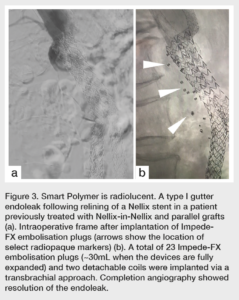This advertorial is sponsored by Shape Memory Medical.

Smart Polymer is a new shape memory polymer technology, available to endovascular specialists, that is incorporated into the Impede embolisation plug family (Shape Memory Medical). Michel Reijnen, a vascular surgeon at Rijnstate Hospital in Arnhem, The Netherlands, has used the Smart Polymer devices in several aortic cases. Here, he gives his perspective on the unique properties of the polymer, and details how Smart Polymer devices may be utilised in a vascular surgeon’s practice.
“Shape memory polymer is a novel material that can be very useful for a range of traditional peripheral vascular embolisation procedures, including the treatment of complications after endovascular aortic procedures,” Reijnen tells Vascular News.
Comparing the Impede embolisation plug family of devices to alternative treatment modalities, Reijnen expresses his belief that the new technology has some advantages over standard embolisation materials like coils and liquids. He elaborates that the embolic material is highly compliant and soft, which may reduce the risk of vessel trauma, and the radiolucent nature of Smart Polymer has only limited impact on imaging modalities after treatment, which makes follow-up “much more reliable”.
Reijnen describes the Smart Polymer used in the Impede device family as a biocompatible, ultra-low-density polyurethane that gently expands when exposed to the warm, aqueous blood environment. The expanded material is porous, enabling rapid formation of organised thrombus throughout its structure. Over time, the polymer stimulates thrombus remodelling and healthy tissue formation as the material gradually absorbs. These micro-level properties have been observed during device development and in animal studies on vascular plugs and coils featuring this Smart Polymer. He explains: “When using bare metal coils, you are inducing clot formation, but we know that sometimes the vessel will reperfuse, which is not the intent.” In his experience, the other difference with Smart Polymer is that it creates a scaffold for cellular ingrowth, resulting in a “more stable occlusion of the vessel” and ultimately formation of healthy scar tissue.
The benefits of Smart Polymer have come to light in Reijnen and colleagues’ aortic practice at Rijnstate Hospital. There are several aortic applications for which the Impede embolisation plug family of devices are ideally suited, says Reijnen, who highlights its aptness for the embolisation of side branches and the treatment of endoleaks. “You can completely fill a type II endoleak [with Smart Polymer devices], and therefore the chance of developing a remaining type II endoleak is likely reduced,” he says. The high-volume filling properties of Smart Polymer have also assisted in the treatment of some particularly challenging cases at Rijnstate Hospital, specifically for the treatment of type I endoleaks. Reijnen details one case in which a patient presented with a gutter endoleak following endovascular aneurysm sealing with parallel grafts. “There was really no regular solution other than embolisation,” says Reijnen. He recalls how the team used Impede-FX embolisation plugs to completely seal the gutter endoleak and expanding AAA sac. “To date, the patient is in good condition—without aneurysmal growth and without endoleak. We are now one and a half years from treatment, so this is a promising result thus far,” he tells Vascular News.
Reijnen adds that Smart Polymer devices could also be used for false lumen treatment, although development of larger plugs may be better suited for that indication. In the future, he foresees Smart Polymer devices being used in primary sac filling, as an “adjunct” to endovascular aneurysm repair (EVAR). At present, Reijnen notes that the team is currently participating in AAA-SHAPE, a prospective, multicentre early feasibility study of the shape memory polymer Impede-FX RapidFill® device when used for abdominal aortic aneurysm (AAA) sac management during elective EVAR. Active sac management with dedicated devices may prove to be a new and crucial step to improve long-term outcomes after EVAR.
The Rijnstate Hospital team has so far only used the technology for aortic pathologies. However, Reijnen points out that it also has potential in the peripheral vasculature for visceral artery embolisation, treatment of arteriovenous fistulas, and management of pelvic congestion syndrome, just to name a few. “Due to its broad range of clinical applications, this novel technology expands embolisation options and could play an important role in one’s endovascular practice,” he concludes.


Disclaimers: Michel Reijnen is a consultant to Shape Memory Medical and principal investigator of the AAA-SHAPE_NLD trial.
Future device applications, prospective studies involving investigational devices, and investigational uses of approved devices are discussed in this interview. The content contains information about AAA-SHAPE, Shape Memory Medical’s prospective investigational studies of the Impede-FX embolisation plug and the Impede-FX RapidFill when us ed for prophylactic abdominal aortic aneurysm (AAA) sac filling during el ective endovascular aneurysm repair (EVAR).
For more information about the AAA-SHAPE studies, please visit https:/ / clinicaltrials.gov/ct2/home
NCT04227054 and NCT04751578
Not all devices discussed in this interview are available in all regions.
In countries recognising CE marking, the Impede embolisation plug, the Impede-FX embolisation plug, and Impede-FX RapidFill are indicated to obstruct or reduce the rate of blood flow in the peripheral vasculatur e.
In the USA, the Impede embolisation plug is indicated to obstru ct or reduce the rate of blood flow in the peripheral vasculatur e and the Impede-FX embolisation plug is indicated for use with the Imped e embolisation plug to obstruct or reduce the rate of blood flow in the peripheral vasculature.
The Impede-FX RapidFill device is not approved for sale in the USA.













